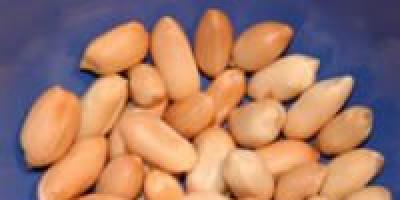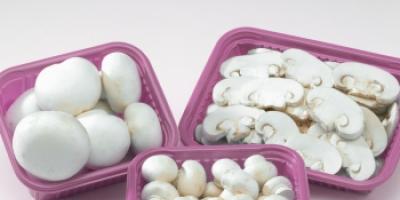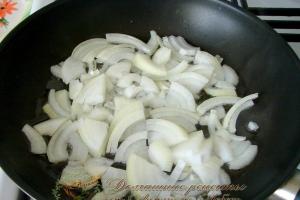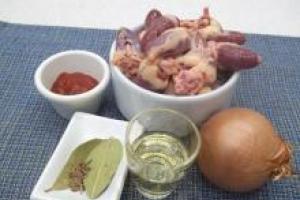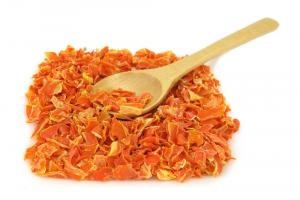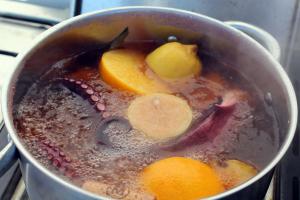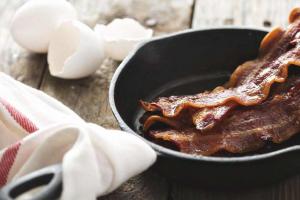Autumn planting of onions before winter allows you to get not only fresh vitamin greens in early spring, but also strong juicy bulbs already at the end of June. Planting before winter has a number of advantages that many summer residents and gardeners enjoy. Despite the risk of freezing in cold weather harsh winters, more and more farmers prefer autumn sowings...
Choosing onion varieties for winter sowing
When planning to plant onions for the winter, you first need to decide for what purpose the planting is being done - to produce greens or turnips. In any case, no matter what kind of seed you plant, green feather will increase. When planting onions in the fall, be sure to pay attention to the winter hardiness of the variety; it is recommended to plant sets that are resistant to frost.
It is advisable to buy zoned onion varieties for planting in the fall, suitable for cultivation in a specific area. Before winter, the following varieties of onions are planted: Black Prince, Strigunovsky, Siberian annual, Ellan, Bessonovsky, Stuttgarten Risen, Danilovsky, Chalcedony, Arzamas, etc.
There is one little trick to planting onion sets before winter: the smaller the oat set, the larger the onion will grow. A small seedling practically does not bolt; a large seedling planted in the fall will shoot almost all of it. It is not recommended to take large sets for sowing turnips in the fall. If you decide to start winter crops for the first time, plant several different varieties to understand which onion grows best in beds in your climate zone.
Landing dates
The time to plant onions in winter is determined by the outside temperature. A favorable period is considered to be when the temperature is in the range from 0 °C to +5 °C, provided that the night temperature is not lower than -3 °C, the ground temperature in this case will be +3 °C or +4 °C, which is what is needed for planting seedlings.
In the photo - autumn planting of onions in the first half of October
Each individual region has its own climatic characteristics, so it is quite difficult to determine the exact time frame for planting seedlings. Gardeners need to independently monitor weather conditions to determine the optimal time for sowing wild oats.
Sowing too early can cause the seedlings to germinate, and with the arrival of frost planting material will die. For example, in middle lane In Russia and the Moscow region, onion planting begins in the second week of October and continues until the end of the month; in Ukraine (for the northern regions), the planting dates shift to October 20-22 and last until November 5-7.
How to plant onions correctly in the fall?
It is preferable to plant onions in sunny areas where water does not accumulate in the spring. The earth is dug up to a depth of 25-30 centimeters, 0.5 buckets of compost, one glass of wood ash are added, all fertilizers are calculated square meter area.
The bed for the seedlings is loosened, then grooves are cut 3-4 centimeters deep at a distance of 11-12 cm. When planted shallowly, the seedling does not tolerate frosts well without snow; in the spring the bulbs will stick out of the ground. Unlike planting in spring, onion sets for autumn sowing do not soak.
Small wild oats are laid out in furrows every 30-40 mm and covered with loose soil mixture or soil. The top is additionally mulched with peat or leaf litter. To get fresh greens in early spring, sow the sets more densely in the fall, every 2 centimeters. In the month of May or earlier, it will be possible to thin out the plantings by tearing out green onions and leave the plants for further ripening for turnips.
Caring for winter plantings in spring
In the spring, as soon as the snow thaws and melts away, the additional mulch layer is removed and sent to compost. The condition of onions planted in the fall can be judged already in April, when the snow melts. If the winter was too cold and little snow, with incorrect agricultural technology, the crops may not grow well. Therefore, it is possible to plant onions again, but you need to plant larger sets in the spring.
To grow large onions planted before winter, in April the plantings must be fed with liquid mullein (1:10). You can speed up the ripening of bulbs using a greenhouse, which can be built on a bed of arcs and film. Any film will do instead non-woven material, retaining and saving heat. Don’t forget to remove weeds from the beds and water them, then the autumn planting of onions before winter will definitely please you with a rich harvest!
March madness is exactly how the first calendar month of spring is perceived by those who grow seedlings of their favorite vegetables themselves. In March, they sow their favorite tomatoes and peppers, carry out the first sowings in the greenhouse, and even sow vegetables in the beds. Growing seedlings require not only timely planting, but also a lot of care. But the troubles are not limited to her. It is worth continuing to sow in greenhouses and on window sills, because fresh greens from the beds will not appear so soon.
As spring approaches houseplants They gradually emerge from their dormant state and begin to grow. After all, already in February the days become noticeably longer, and the sun warms up like spring. How to help flowers wake up and prepare them for the growing season? What do you need to pay attention to and what measures should you take to keep your plants healthy, blooming, multiplying and making you happy? We’ll talk about what indoor plants expect from us in the spring in this article.
One of the most important rules growing strong and healthy seedlings- presence of the “correct” soil mixture. Typically, gardeners use two options for growing seedlings: either a purchased soil mixture or one made independently from several components. In both cases, the fertility of the soil for seedlings is, to put it mildly, questionable. This means that the seedlings will require additional nutrition from you. In this article we will talk about simple and effective fertilizers for seedlings.
After a decade of catalog dominance by original variegated and colorful tulip varieties, trends began to change. At exhibitions best designers world offer to remember the classics and pay homage to the charming white tulips. Sparkling under the warm rays spring sun, they look especially festive in the garden. Welcoming spring after a long wait, tulips seem to remind us that white is not only the color of snow, but also the joyful celebration of flowering.
Despite the fact that cabbage is one of the most popular vegetables, not all summer residents, especially beginners, can grow its seedlings. In apartment conditions they are hot and dark. High-quality seedlings in this case it is impossible to obtain. And without strong, healthy seedlings it is difficult to count on a good harvest. Experienced gardeners know that it is better to sow cabbage seedlings in greenhouses or greenhouses. And some even grow cabbage by direct sowing seeds in the ground.
Flower growers tirelessly discover new indoor plants, replacing some with others. And here the conditions of a particular room are of no small importance, because plants have different requirements for their maintenance. Lovers of beauty often face difficulties flowering plants. After all, for flowering to be long and abundant, such specimens require special care. Unpretentious plants There are not very many flowers blooming in rooms, and one of them is streptocarpus.
Chicken cordon bleu rolls with béchamel sauce is an excellent dish for festive table and daily meals! It’s easy and quick to prepare, it turns out juicy, and the thick bechamel sauce is finger-licking good! WITH mashed potatoes, pickled cucumber and a slice of fresh bread will make a hearty and tasty dinner. Choose the cheese for this recipe according to your taste, processed or blue mold. It is important that the cheese and ham are sliced very thin, this is the secret of success!
Calendula (marigold) is a flower that stands out among others with its bright color. Low bushes with delicate orange inflorescences can be found on the side of the road, in a meadow, in the front garden next to the house or even in vegetable beds. Calendula is so widespread in our area that it seems like it has always grown here. About interesting decorative varieties calendula, as well as about the use of calendula in cooking and medicine, read our article.
I think many will agree that the wind is well perceived by us only in the romantic aspect: we are sitting in a cozy warm home, and the wind is raging outside the window... In fact, the wind blowing through our areas is a problem and there is nothing good about it. By creating windbreaks with the help of plants, we break the strong wind into several weak currents and significantly weaken it destructive force. How to protect a site from the wind will be discussed in this article.
Making a shrimp and avocado sandwich for breakfast or dinner couldn't be easier! This breakfast contains almost everything necessary products, which will recharge you with energy so that you won’t want to eat until lunch, without adding extra centimeters to your waist. This is the most delicious and light sandwich, after, perhaps, the classic cucumber sandwich. This breakfast contains almost all the necessary products that will recharge you with energy so that you won’t want to eat until lunch.
Modern ferns are those rare plants antiquities, which, despite the passage of time and all kinds of cataclysms, not only survived, but were also largely able to preserve their former appearance. Of course, it is not possible to grow any of the fern representatives indoors, but some species have successfully adapted to life indoors. They look great as single plants or decorate a group of decorative foliage flowers.
Pilaf with pumpkin and meat is Azerbaijani pilaf, which differs in the method of preparation from traditional oriental pilaf. All ingredients for this recipe are prepared separately. Rice is boiled with ghee, saffron and turmeric. The meat is fried separately until golden brown, and pumpkin slices as well. Separately prepare the onions and carrots. Then everything is placed in layers in a cauldron or thick-walled pan, a little water or broth is poured in and simmered over low heat for about half an hour.
Basil is a wonderful universal seasoning for meat, fish, soups and fresh salads- well known to all lovers of Caucasian and Italian cuisine. However, upon closer inspection, basil turns out to be a surprisingly versatile plant. For several seasons now, our family has been happily drinking aromatic basil tea. In a flowerbed with perennials and in flowerpots with annual flowers, bright spice plant a worthy place was also found.
Thuja or juniper - which is better? This question can sometimes be heard in garden centers and markets where these plants are sold. It is, of course, not entirely correct and correct. Well, it’s the same as asking what is better - night or day? Coffee or tea? Woman or man? Surely, everyone will have their own answer and opinion. And yet... What if you approach with an open mind and try to compare juniper and thuja according to certain objective parameters? Let's try.
Preface
Planting onion sets before winter allows you to avoid many of the inconveniences that are typical for spring planting. In order not to make a mistake in the fall, let’s figure out what steps need to be taken?
Varieties and advantages of planting seedlings before winter
Onions are an extremely popular plant that can be found in literally every garden. But this root vegetable is quite capricious. For example, in dry weather it can throw out arrows, but in damp weather it begins to rot. These problems can be solved if you switch to planting onion sets for the winter. If certain simple rules you can get bountiful harvest before everyone else - in the month of July.
The method of planting onion sets in autumn has a number of advantages over traditional spring planting. In this case, you will be able to harvest almost a month earlier than usual. Moreover, onions planted before winter are not afraid of a dry spring. After all, the seedlings will be able to feed on melting snow. Before the summer heat sets in, you won’t have to waste time watering the root crops.
Also, onion sets planted before winter are characterized by increased vitality and strong, well-developed rhizomes. This method provides the gardener with the opportunity to divide planting work into autumn and spring period, which makes his work much easier. Onion sets, planted before winter, produce friendly and uniform shoots. And the collected root vegetables turn out to be larger, juicier, and more aromatic.
The presented planting method allows you to protect the plant from such dangerous pest, How onion fly . After all, during the germination of seedlings, the insect is still in hibernation. Onions planted before winter are not prone to bolting, fungal infections or rotting. Autumn way planting provides higher yields. And bulbs grown from sets planted in the fall are perfectly preserved until spring. Moreover, you can store them not only in the cellar, but also at home.

But not every onion is suitable for planting in the fall; first of all, you will need to decide on the varieties. The most suitable for this will be specially developed onion subspecies, which are characterized by a high degree of cold resistance. The following are considered to be the most famous and unpretentious: Bessonovsky, Arctic, Ellan, Stuttgarter, Uralsky, Danilovsky, Radar, Strigunovsky and Sibiryak. Heat-loving southern onion varieties are not suitable for planting under snow, because as soon as the first cold weather arrives, the seedlings will simply die in the frozen ground.
Preparing a bed for onion sets
Of course, you should start by choosing a landing site. The beds must be well lit and also ventilated. It is not recommended to plant sets in the ground where garlic, beets or carrots previously grew. And one more little secret: this plant simply does not tolerate excess moisture, so choose a place for its location that is not subject to stagnation of melt or rain water.
Now it’s time to prepare the soil. First, the area must be thoroughly weeded, clearing it of weeds. And then the soil needs to be thoroughly dug up and saturated with a mixture of ash and humus. Superphosphate is also perfect for these purposes. organic fertilizers or compost. And the third step preparatory stage will be pre-planting treatment of bulbs.

If you want to achieve high yield, the seedlings also need to be properly prepared before autumn planting. There are two popular processing methods. In the first case, the tubers are wiped with a solution copper sulfate. Second option: the bulbs should be placed in boiling water for just a few moments. These manipulations will protect the plant from possible fungal diseases, as well as summer bolting.
For more active growth of tubers, immediately before planting in the ground, it is recommended to wrap the bulbs in fabric and place them in glassware and place in the microwave for one and a half minutes.

When should all these preparatory activities be carried out? The ideal time for onion sets is considered to be between the 5th and 20th of October. It is very important to do this without waiting for a serious frost to give the onions a chance to properly take root and gain a foothold in the soil. So by October you should already buy planting material, decide on a location and prepare yourself for work.
Planting seedlings before winter - simple rules
So, when the time has come to the target date, the first preparatory measures have been carried out, and the bed has been dug up, you can start planting. First, rake the site of the future onion plantation to level it out. upper layer soil. Form a base for the beds and thoroughly loosen the area. According to experienced gardeners, the ideal height of an onion bed is considered to be 20 cm and a width of 100 cm.

At the next stage, you will need to make special grooves about 4 cm deep. Please note that they should be at a distance of approximately 25–30 cm from each other. Carefully place the pre-treated and dried onion sets into the resulting grooves. Please note that the distance between tubers should be no less than 10 cm.

Next, the planted bulbs must be covered a few centimeters with humus and peat mixture. When completing the process, carefully level the surface of the landing site using reverse side rake. If severe, frosty winters are expected, then onion sets should be additionally insulated. To do this, cover the beds with a layer of fallen leaves and sprinkle loose snow on top. At this point, the landing can be considered complete!
How to care for such onions in the spring?
Further care for onion sets planted before winter is quite simple. As soon as spring comes, remove from the beds protective covering from leaves and clear the snow to avoid water accumulation during melting. After this, fertilize the soil with urea. Then the place of the onion plantation should be loosened. Do this carefully so as not to injure the sprouts. When all the seedlings have sprouted, the bed will need to be thinned out. The distance between the bulbs should be about 5–7 cm.

When the process of tuber formation begins, feed the crop with fertilizers that include sodium and phosphorus. Summer residents with experience advise using for these purposes liquid fertilizer, since it is believed that it is absorbed better and faster. Another recharge option is fermented infusions from medicinal herbs with the addition of ash and humus.

In order to protect young onion sets from all kinds of pests, it is recommended to lay out layers of herbs such as tansy, wormwood or yarrow on the site. The garden bed should be watered from May to mid-June. Further moisture may cause tubers to rot.
Harvesting, sorting and storage
To ensure that the resulting onion harvest is well preserved, it is also recommended to follow a few simple rules. It usually ripens by the beginning of July. After the foliage of the plant has fallen, it will be necessary to pull the tubers out of the ground and dry thoroughly. Experienced gardeners consider the main sign of perfectly dried onions to be the easy separation of their leaves and roots.

Harvesting is best planned on warm, dry days. Unripe bulbs are not subject to long-term storage, so they should be set aside separately and added to food as quickly as possible. Harvest It is recommended to sort according to the size of the tubers. It is believed that large onions are best suited for long-term storage. Medium-sized tubers (approximately 4-5 cm) are ideal for planting in boxes to produce green onions. It is recommended to leave small sets for subsequent plantings.
14.07.2017
9 725
How to plant onions before winter so as not to rot and give a generous harvest?

With the arrival of autumn, many summer residents are interested in how to plant onions before winter in order to grow a rich harvest and, most importantly, when, in what time frame? What are the agricultural techniques, at what depth to plant, at what distance, do you need to water after planting, do you need to soak the seeds before planting, what variety to choose, what to cover for the winter - a number of questions, the answers to which will help you grow winter plantings without any problems...
When to plant onions before winter - timing
Experts say that onions can be planted in the ground not only in spring, but also in autumn. However, the latter method was not widespread until recently and only today has gained popularity among gardeners. For this purpose, it is worth choosing special ones - winter varieties of onions that are not afraid of cold weather and survive the winter well right in the ground.

Autumn planting of onions before winter begins in the last days of September and ends in the first ten days of November, depending on the planting region and weather conditions. The signal to start planting wild oatmeal can be the temperature on the street thermometer, which remains at +5 °C degrees for several days in a row, while the night temperature should not be lower than -3 °C. As a rule, the soil temperature will be +3 °...+4 °C, which is necessary for planting onion sets before winter.
Some summer residents prefer to be sure and not make a mistake. In this case, if you trust the heavenly body, keep in mind that the weather can be unpredictable, and the likelihood of getting a rich harvest will be reduced to a minimum. Sudden thaws or sharp frosts, which are not to the liking of winter plantings, will simply destroy the planting material, one way or another.
Experienced farmers do not trust dates and rely on weather conditions: before it gets cold outside, onions must develop their root system. It is impossible to allow green shoots - feathers - to appear. If onions are planted in the ground ahead of schedule, they will germinate and then freeze. Late boarding will result in the seedling not having time to take root and rotting.
Territorial features of growing onions before winter
Requirements for how to plant onions before winter will vary depending on the area. So, for example, when to plant onions before winter in the Moscow region, Leningrad, Pskov, Smolensk, Kostroma, Lipetsk, Voronezh regions depends on temperature conditions on the street. Special attention in this case, it is worth paying attention to the too frosty winter. For the purpose of prevention, when severe frosts occur, a lot of snow is thrown on the beds with onions, and in snowless winters they are mulched with peat and leaf litter. If the winter is snowy, then under the cover of snow the onions are not in danger of freezing.
The technique of planting onions before winter in the Urals and Siberia differs in that it is necessary to start planting earlier, in early autumn; it is better to do this before mid-October, or even earlier, due to the climatic characteristics of the growing region. It is also worth noting that not every variety of winter onion is suitable for cultivation in this zone; you need to choose varieties with high winter hardiness. Be sure to cover the plantings!
Planting onion sets in the Kuban and throughout the Krasnodar Territory, Astrakhan, Volgograd, Rostov regions, also in the republics of Adygea and Crimea, can be carried out much later than the conventional deadlines, here the warmth sometimes lasts until November, and accordingly, planting is carried out at a later date.
Rules for planting winter onions
Low onion yields can often be explained by the poor preparation of the owner of the plot for growing vegetables. Few people know how to plant onions before winter in order to get a rich harvest. First of all, do not forget that onions after onions can be planted only after two years, then the planting location must be changed. It is optimal to plant winter onions after crops such as grains, beets, tomatoes, and cabbage. It is not recommended to plant onions after potatoes or beans.
Before planting onions before winter, and in order to have a large fruit, it is necessary to properly prepare the set for planting. Onions must be sorted by size; they are divided into wild oats (less than 1 cm in diameter), sets (1–3 cm) and selection (more than 3 cm). For green feathers, the last option is suitable; for large fruits, it is better to plant small sets for the winter. Large bulbs in most cases go into the arrow.
Many gardeners are wondering whether to cut onions before winter or not? Agronomists have a clear answer - no, you can’t prune. If you prune, you may lose the harvest, because cutting off the top tail in the spring promotes faster germination of the bulbs. If you cut off the bottom of the seedlings in the fall, they simply won’t take root and will rot in the ground in the winter.
It is important to choose the right soil where our vegetable will grow. Perfect option– drained humus-sandy soil or loam rich in humus. The soil must be rich in nutrients so that in poor soil good harvest you can't wait.
Next, you need to figure out how to plant onions before winter, at what depth to do it. In the prepared bed we make grooves, the depth of which is approximately 5 cm, and the distance between the rows is 20 cm. Place the bulbs 7-10 cm apart with the bottom down and sprinkle with earth. Planting at such a depth is considered optimal so that the seedlings do not die in the winter and germinate well in the spring. No need to water. You can plant the sets thicker, after 3-5 cm, then in May you will need to thin out the bed, pulling out the specimens for greenery and leaving the onions in the ground for a large turnip.
If the soil is fertilized, you can sprinkle a little wood ash into the furrows before planting, which is not only an excellent fertilizer, but also resists fungal diseases. Humus (1/2 bucket), compost is added to depleted soils, and mineral complexes are added. Fresh manure is not applied when planting onions in the fall. With the onset of cold weather, the bed needs to be mulched with any available material - withered leaves, peat, sawdust, spruce branches, etc.
A lot of controversy arises about the fact that onions are planted only on greens before winter - it’s not true, they are also planted on large turnips. The advantage of winter planting is that the bulbs grow larger and the harvest can be harvested as early as early July. It is worth noting that in the fall it is not produced.
In the spring, when the soil has warmed up sufficiently and the threat of frost has passed, remove the mulch from the beds. It is important to do this in time, before the onions begin to sprout. Don't forget to loosen the soil and fight weeds and pests.
The most popular varieties of winter onions
What varieties of onions for winter are especially popular among leading experienced gardeners? Let's talk about a few:
- Rubin is a variety bred by Donetsk breeders. The vegetable has a light purple color, large bulb size, and is suitable for long-term storage.
- Buran – universal variety, it is characterized by a large round bulb and bright yellow color. The variety has high level productivity, is well stored, its main drawback is instability to downy mildew
- Black Prince is one of the varieties of purple onions, which has a round, dense bulb and an islandy taste.
- Onions for winter Radar – Dutch variety, resistant to both frost and drought. The bulbs are characterized by high density and a beautiful yellow color.
- Siberian onion – best option growing on a feather. The shape of the bulb is flattened at the poles, the color is yellow. The variety not only stores well, but is also resistant to arrowheads.

in the bag there are different varieties of onion sets - in the photo
These are not all winter varieties; Sturon is also suitable, but now you know how to plant onions before winter! Have a good harvest!
Such a different bow. It may be yellow or purple. It is grown for bulbs and feathers. Moreover, this crop can be planted both in autumn and spring.
Numerous experiments indicate that by planting onions before winter, it is possible to obtain an earlier harvest and winter planting significantly saves time spring planting. By the way, the seedlings turn out to be practically unaffected by common pests.
Onion varieties for planting before winter
Of course, you can try and plant sets of different varieties. But there are certain varieties that have increased frost resistance and resistance to bolting.
If we talk about which onions are best to plant before winter, then we need to mention varieties such as Bessonovsky and Strigunovsky. Among other things, they are also characterized as early ripening. Therefore, they can be harvested at the end of June.
- Ellan, it is designed specifically for winter plantings and this the best varieties onions before winter;
- Arzamas;
- Chalcedony;
- Odintsovets;
- Myagkovsky-300;
- Danilovsky-301;
- Stuttgarden, which also adapts well to autumn planting and is characterized as particularly spicy.
If possible, plant onion sets before winter, the varieties of which are different. Next summer, decide which one is best suited for your specific climate. They also correspond to the tastes and preferences of gardeners.
Planting onions before winter
First you need to choose a place for the garden bed. It is desirable that the predecessors be something from the following list: potatoes, beans, tomatoes or cucumbers. The space should be fairly dry and well lit.
In addition, planting onions in the fall before winter should be done in dug up and well-loosened soil. It is supposed to add humus or compost, to which is added wood ash. You need to prepare a bed about a meter wide for onions well in advance of planting onions before winter. Because the soil must settle and compact.
Then it’s worth deciding on the timing that will be optimal for planting. You need to choose a period a month before frost. During this time it will have time to take root and will not germinate. For example, the time to plant onions before winter in the Moscow region is in the first two decades of October.
Another nuance of planting is related to the size of the set. The optimal size for obtaining good bulbs will be 1-1.5 cm. They should be buried 2-3 cm; at 4 cm it will no longer germinate.
It is also possible to plant onions on greens before winter. If you need to get a good feather, then you should choose sets up to 3 cm in diameter. It is planted to a depth of 6 cm. You can also choose varieties of multi-tuber onions or family onions.
Planting nigella onions before winter. Do they sow onions before winter with nigella?
You can collect nigella onions yourself in mid-summer from ripened onion heads
Let's start with the name. These are just onion seeds. From them grow sets, which then become large onions. Someone may have a question about whether it is possible to plant onions from seeds before winter. It turns out that yes.
To do this you will need to prepare a bed. The soil should be loosened and mulched with peat. Make ditches about 3 cm deep, at a distance of about 20 cm from each other, and leave them until frost sets in. Then the time comes when nigella onions are sown before winter. The seeds need 2-3 cm of humus on top. During the winter months, you should ensure that the bed is covered with snow.
Planting onion batun
Onions are grown for their green feathers, not for their bulbs.
This perennial can exist in one place without transplantation for about five years. In order to get a harvest in the second year, you need to sow it from the second half of June to mid-summer. This is the optimal time to plant onions; you should not do this before winter. Because by frost it should already have grown to a state where the number of its leaves reaches 3-4.
It is used for food when the greens become 10-15 cm in length.
For better growth For onions, you need to choose loamy soil and apply fertilizer before planting. It can be nitrophoska or superphosphate, or you can use humus or compost. Experts recommend making rows of onions at a distance of 25 cm, and lowering the seeds into the ground to a depth of no more than 2 cm.
Family bow for winter.
The family onion has an oblong, elongated shape and grows in small sizes.
It is also called shallot in another way. In it, 3-10, and sometimes 20, develop from one bulb. It is usually planted in the spring in late April - early May. Then he actively uses melt water and his active growth falls on the most long days per year.
Experts say that it is possible to plant onions before winter in the Moscow region if a large number of little children. Such that their size is less than one centimeter. Only in this case it will not shoot and bloom.
Winter planting of onion sets.
Tell:


